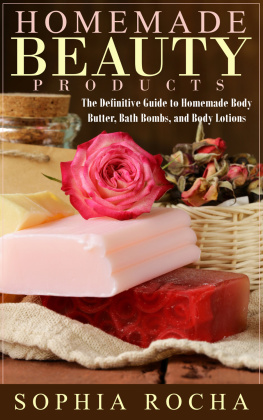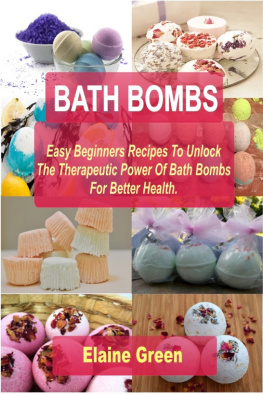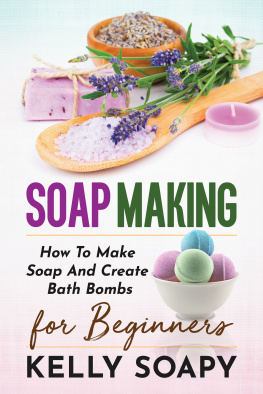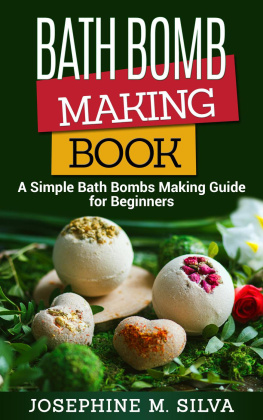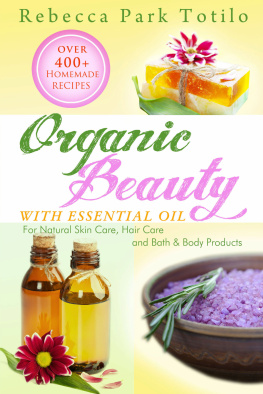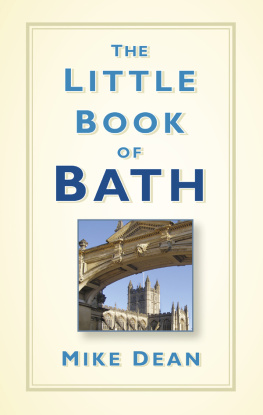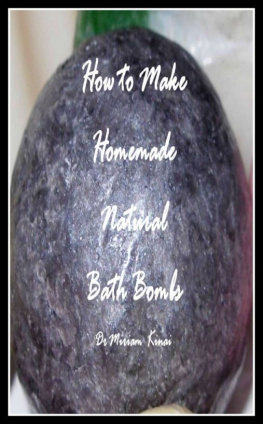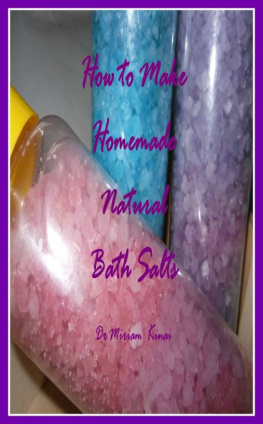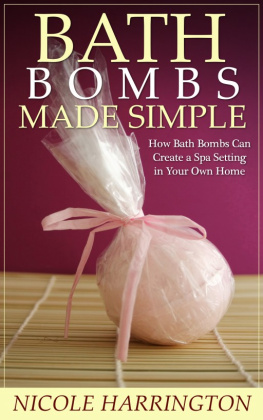The Bath and Body Book DIY Bath Bombs, Bath Salts, Body Butter and Body Scrubs
All Rights Reserved. No part of this publication may be reproduced in any form or by any means, including scanning, photocopying, or otherwise without prior written permission of the copyright holder. Copyright 2014
Table of Contents
The Recipes
Bath Bombs
Introduction My family is rather large and filled with aunts and uncles, nieces and nephews, cousins and those twice removed. And while I love having a large family, it can be nerve racking and a bit expensive when the holiday season rolls around. At one point, I began baking cookies as gifts. Not only did it save me money, but also I was able to reduce a bit of stress since I didnt have to go from store to store trying to find gifts for everyone.
Unfortunately, the cookie debacle of 2006 (as it has since become known) ended up with my uncle spending time in the emergency room because of some rather delicious chocolate chip cookies that I made with a bit of cinnamon to spice them up. Now how was I supposed to know he was deathly allergic to cinnamon? So it was back to the drawing board to think of something else I could do. I didnt want to continue to bake knowing that I couldnt possibly remember who was allergic to what and I didnt want to take the chance of someone else having a bad experience with my cooking. So I began scoured the internet and craft books trying to find something else I could make as gifts. I thought about crocheting, but my Grandmother was the crocheter of the family and there was no way I could rival her skills. After what seemed like weeks, I finally stumbled upon bath bombs.
Bath bombs are these nifty little things that you toss in your bath. They create a foamy, bubbly action that can help relax tired muscles and leave your skin feeling soft and refreshed. Besides being easy to make and very budget-friendly, one of the great thing about bath bombs is that, despite the popularity of homemade gifts, there probably wont be another member of you family making them to give out as presents. Bath bombs are also very versatile, which means you can make them to fit anyones personal needs, taste and style. For example, my older female cousin loves seashells and her bathroom has a pink color scheme, while her daughter loves cats and the color peach. Taking that into consideration, I was able to make them both seashell and cat-shaped bath bombs in the coordinating colors.
I began making bath bombs as Christmas presents in 2007, and they were -- and still are -- a hit! My family members actually look forward to receiving them, and have even called me up in the middle of the year asking if I could give them a few more bath bombs to hold them off until the holiday season rolls around.
Basic Ingredients
While every bath bomb recipe varies from one another, there are a few common and basic ingredients that are necessary to successfully create bath bombs; baking soda and citric acid. However, even the basic ingredients of bath bombs may vary depending on the recipe you use. For instance, some people have a hard time finding citric acid so there are a few recipes for bath bombs that dont require the use of citric acid. Keep in mind, however, that it is the citric acid -- along with the baking soda -- that creates those wonderful bubbles when the bath bomb is added to water.
What is Citric Acid and Where to Find It Most of the ingredients for bath bombs are relatively easy to obtain, except for citric acid.
What is Citric Acid and Where to Find It Most of the ingredients for bath bombs are relatively easy to obtain, except for citric acid.
Citric acid is a natural product and is what gives lemons their sour taste. In fact, citric acid is used in various products and process. It is often used in cannoning as a preservative and its used for cleaning and water softening. Consider looking for citric acid near the canning section of your local grocery store. You can also check with the health food store in your area since they may carry it in bulk. Citric acid is sometimes called sour salt, so you may have to use that terminology when searching for the item.
Another option is to simply purchase citric acid from one of the many online merchants who carry it.
Getting it Just Right
One of the most important aspects of successfully creating bath bombs is achieving the right consistency. This is actually the trickiest part of the entire process. Once you have it down, however, creating bath bombs will be a breeze. Whats so problematic is that every little thing can have an effect on the mixture. Every type of fragrance oil reacts differently to the bath bomb mixture, and even the weather can negatively impact the bath bomb making process.
Yep, you read that correctly: The humidity level can actually affect the bath bombs and make it difficult to achieve the right consistency. The perfect consistency for bath bombs is like damp sand that you can pack together with your hands. If the mixture is too wet, it will: Feel like doughy like Play-Doh, sticks to your fingers Feel overly wet If the mixture is too dry, it will: Be crumbly, hard or pebbly Feel like dry sand that slips through your fingers Clump together only for a few seconds before crumbling apart If the bath bomb is too wet, you can try adding a bit more of the prepared dry mixture to it. However, you should ensure it keeps the proper ratio of 2 parts sodium and 1 part citric acid. Having too much or too little of the sodium or acid will affect on how fizz the bath bombs produce. If the mixture is too dry, simply add a bit more of the liquid ingredients to the dry.
Molding the Bath Bombs While it may sound simple enough, adding the mixture to the mold can be a bit tricky. This is due to the fact that the mixture has to be tightly packed into the mold. To properly mold the bath bombs you should spoon a bit of the mixture into the mold and then pack it in tightly with your fingers or the back of the spoon. Add a bit more mixture and pack again. Continue in this manner until you have filled the entire mold with the mixture.
Bath Bomb Recipes
Basic Bath Bomb This first recipe Ingredients: 2 cups of baking soda 1 cup citric acid 1 cup Epsom salt 1 teaspoon water 3 tablespoons light vegetable oil Directions: Step 1: Mix the dry ingredients together in a bowl.
Step 2: Mix the liquid ingredients in Step 3: Slowly add the dry and liquid ingredients together, mixing together with a whisk. The mixture should have the consistency of damp sand, clumping together when squeezed into a ball.
Bath Bombs without Citric Acid Recipe Ingredients: 2 cups baking soda 1/2 cup cream of tartar Water Essential oil (optional) Food color (optional) Directions: Step 1: Combine the baking soda and cream of tartar together. Add the essential oil and color if desired, and mix thoroughly. Step 2: Add 1 teaspoon of water at a time, mixing after each one is added, until you can squeeze the mixture in your hand and it clumps together. If the clump begins to fall apart, you need to add a bit more water.
Step 3: Press the bath bomb mixture into the molds, making sure it is packed very tightly and let set for a few minutes. Gently tap the bath bombs out of the mold and let them dry overnight. White Tea and Coconut Oil Bath Bomb Recipe Ingredients: 1/2 cup cornstarch 1 cup baking soda 1/2 cup citric acid 2 tablespoons Epsom salts 2 tablespoons coconut oil 5 teaspoons of strong white tea (water can be used as a substitute) Few drops of the essential oil of your choosing, optional All-natural food coloring, optional Mold Airtight container Directions: Step 1: Mix cornstarch, baking soda, citric acid and Epsom salts together in a large bowl. Use a whisk to work the coconut oil in to the dry ingredients. Continue until the mixture becomes sandy with some chunks of oil. Step 2: Add the white tea to the dry ingredients 1 teaspoon at a time, making sure to immediately stir with a large wooden spoon after each teaspoon is added.
Next page


